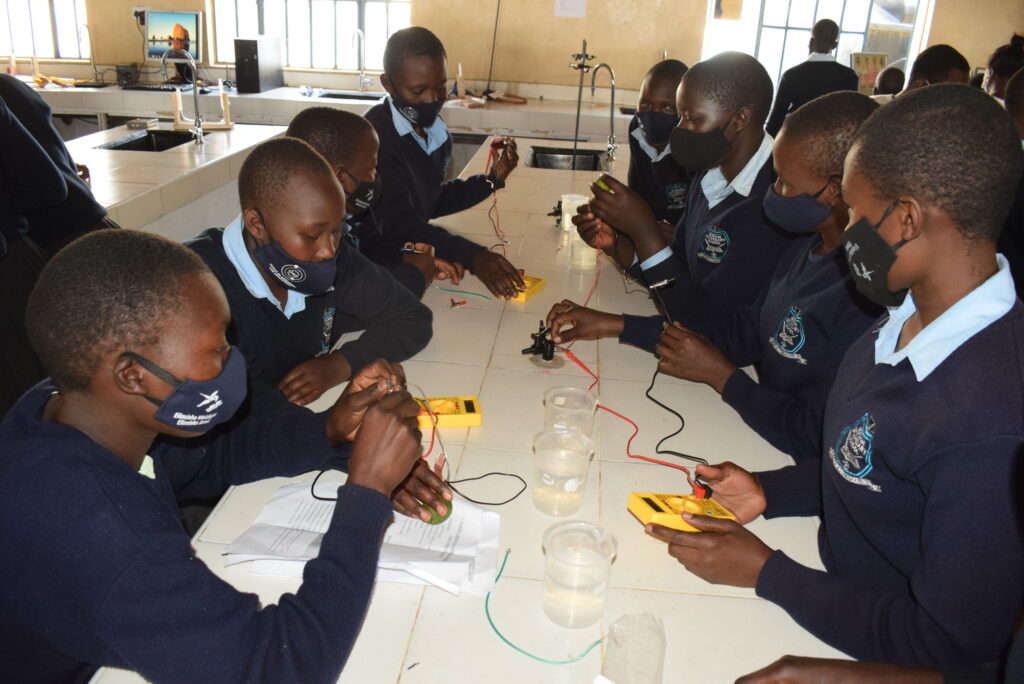The Elimisha Msichana Elimisha Jamii na Astronomia (EMEJA) project, Swahili for ‘educate a girl child, educate the entire community with Astronomy’ or rather, society benefits when a girl is educated, supported by funding from the IAU-Office for Astronomy for Development, targets girls education issues in rural Kenya. The project used multiple interventions to tackle the issues – astronomy STEM workshops, mentorship, and scholarships – guided and supported by long-term student tracking and monitoring.
1. Mentorship and outreach scheme aimed to address most of the socio-economic challenges hindering the continuation of education post-primary school for girls, such as teenage pregnancies. The team visited 10 primary (Noigam, Tulon, Osorongai, Kapsirowa, Kiptenden, Mitombili, St. Peters, Sango, Kipkeikei and Cheptiret) schools in Kitale and engaged 297 (2020 KCPE candidates) schoolgirls in their final year of primary education. EMEJA mentors, the pupils and their teachers, highlighted and discussed positive ways in which the girls can handle their challenges.
2. Tracking and long-term monitoring: The objective is to track the EMEJA mentees throughout high school and to ensure that all EMEJA mentees enrolled in secondary schools. EMEJA mentors kept track of their mentees, 230 schoolgirls (2019 EMEJA mentees) in Year 1 of secondary education. This was done through phone calls, twice in the year. The project also linked the above 297 schoolgirls (EMEJA class of 2020) with personal mentors to be followed by long term tracking and monitoring.
3. Astro-STEM workshops and mentorship: The key objectives were to: a) change misconceptions about STEM subjects among schoolgirls and facilitate early participation of girls in sciences; b) improve grades in STEM subjects; c) increase the number of girls selecting Physics in Year 3-4 and sitting for the Physics national examination; d) increase enrolment of girls in STEM courses at the tertiary level; and lastly, e) to develop critical infrastructure in target schools such as equipping the Physics laboratory with the necessary and basic lab equipment facilities. EMEJA engaged 547 girls in Year I & II across 4 schools: St. Peters Girls, UPEC Girls Osorongai and Noigam in Kitale and Igikiro Mixed Day Secondary school in Murang’a. The students participated in hands-on science practicals such hydronamics and electricity generation in the laboratory and were also provided STEM mentorship and career advice from women with STEM backgrounds.
4. Computer Literacy. The objective were: a) introduce the students in Astro-STEM to computers; b) create resources (computers) for the target schools so as to facilitate the teaching of computer studies. To facilitate this, EMEJA donated 7 computers to two secondary schools, St. Peter’s Girls and UPEC Girls Osorongai. UPEC Girls Osorongai created space for a computer laboratory and is now offering computer studies subject as part of the Kenyan curriculum for secondary education. St. Peters Girls are also in the process of creating space for a computer laboratory.
5. EMEJA tuition fee scholarship: The overarching objective for this program is to ensure a 100% KCPE-KCSE (100% primary-secondary education transition and completion) transition for EMEJA Mentees. Lack of school fees is a key reason for school discontinuation in rural areas and disproportionately affects girls. The project paid secondary tuition fees for 3 girls from disadvantaged economic backgrounds.
EMEJA’s impact
- The project engaged 1074 schoolgirls (+a few boys) in both primary and secondary schools, 16 secondary school teachers, numerous primary school teachers, and 10 tutors.
- As a result of the interventions, the number of girls selecting Physics in Year III shot up across the 4 schools. Particularly, UPEC Girls Osorongai went from 1 female student in the Physics class before Astro-STEM to 17 female students after the Astro-STEM workshop and St. Peters increased from 11 girls to 33 girls in the Physics class!
- Science teachers have reported that there is a notable difference in the attitude of their female students towards sciences and particularly, Physics across the 4 schools. More and more girls are participating in science activities. EMEJA has contributed towards changing misconceptions about STEM subjects among these schoolgirls and also facilitated early participation of girls in science.
- Teachers reported an improvement in grades, particularly in Physics. UPEC Girls improved from an average score of 37 to 45 and St. Peters Girls scores improved from 49 to 52.
- Four secondary schools were provided with Physics lab equipment such as lab stands, multimeters, conducting rods and wires, bulbs etc.
- Two secondary schools were funded to purchase 7 computers, with one school already offering computer studies subject which is part of the Kenya secondary education curriculum. This subject is not offered in many schools due to lack of computers.
- Feedback from the headteachers in Kitale notes that there is a notable increase in the number of girls enrolling for secondary education in the last two years following the EMEJA project. The project appears to have capped absenteeism among school girls as reported by the school heads.
- Finally, EMEJA has facilitated access to secondary education by sponsoring 3 girls with tuition fees scholarships

